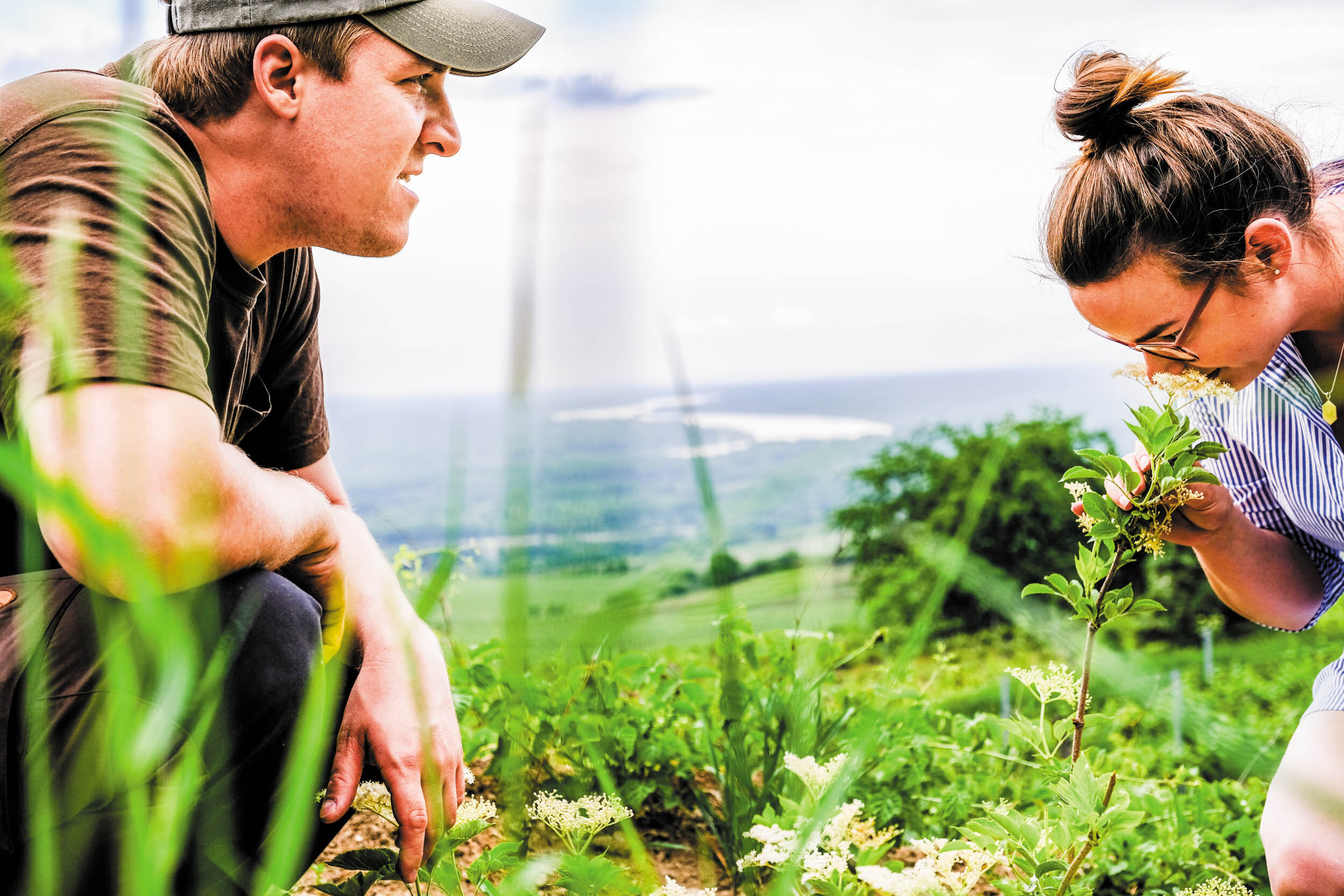Biodynamics
The Greeks believed their god of Harvest, Demeter, changed the seasons with her emotions. During winter, when her daughter was lost to the underworld, Demeter’s sadness gave way to bitter cold, causing plants and animals to retreat, stop growth, and eventually wither.
But in autumn, after her daughter’s return, Demeter’s joy brought bounty beyond man’s wildest dreams. Nature sprung up into colorful celebration: amber gold in wheat, squash, and olives; ruby in apples and cranberries; emerald in fresh vegetables and herbs; royal purple in eggplants; and of course, the deep garnet red of delicious wine.
The legend of Demeter helped farmers withstand the toils of the seasons before industrialization. Since they didn’t have the machines or chemicals of modern agriculture, they relied on the land. Soil, sun, wind, rain – farmers in Greece, Italy, Spain, and northern Africa needed an intimate knowledge of the natural elements to produce fruitful harvests.
What if the rains didn’t come? They didn’t have irrigation systems to help. What if weeds overtook their zucchini plants, or locusts damaged their vine leaves? They could not spray herbicides and pesticides to save them.
Instead, farmers got creative. They planted rose bushes to gauge mold risk, fertilized soils with fermented vegetables and tea, encouraged floral growth to attract pollinators like bees, and kept certain weeds to distract foraging animals from tasty fruit.
These practices worked. The most fertile, fruitful civilizations around the globe were founded on their principles.
Today, a few growers are bringing them back. Simple, instinctual, and harmonious. They harness the power of their ecosystem to produce strong, healthy crops that can withstand natural risks and bring bounty.
The best way to see these practices in action is biodynamic farming. How can you produce incredible, delicious food without modern help? Biodynamics hold the key.
BIODIVERSITY IS KING
Modern day agriculture is based on the idea of monoculture: a single crop per farming system. A farmer decides to cultivate thousands of acres of corn, soy, or wheat – and nothing else.
By focusing on one crop, the farmer may create a more efficient, effective way to scale production and meet increasing demands.
Ancient farming advocates the opposite approach. Biodiversity is the goal, with a focus on propagating complementary species of plants, animals, insects, and bacteria. Then, these living organisms can help each other grow and build resilience.
Take the soils of a vineyard, for example. Plant life relies on a healthy balance of nutrients like nitrogen, carbon, and oxygen in the soil. If there’s too much of one or not enough of the other, plants will die.
Vines like nitrogen and they use it for energy. So, biodynamic farmers may plant buckwheat in the vineyard, which adds nitrogen into the soil through its roots. Or perhaps for younger vines that are not using as much nitrogen from the soil, a biodynamic farmer may plant rye, which converts nitrogen into carbon, or tomatoes, which can help suck nitrogen from the soil.
All this competition between the crops, herbs, and vines for soil nutrients encourages the vines’ roots to grow deeper in search of more energy. This makes them more resilient, grounded in a deep layer of earth with thick, strong roots.
In this way, a farmer can maintain fertile soils and make her vines more resilient without chemicals. She uses a biodiverse system of plants, crops, herbs, and flowers instead.
WORK WITH, NOT AGAINST
Biodiversity is the bedrock for biodynamics.
But what if something goes wrong? Insects come, weeds sprout, humidity rises, or fungus grows - what can a biodynamic farmer do?
Modern farming provides quick ways to resolve issues: insecticide for insects, fungicide for fungus, and so on. This temporarily kills the problem, but it doesn’t address the underlying issue: why did the insects arrive or the fungus start growing in the first place?
Biodynamic farming works in rhythm with Nature, not against it. And biodynamic farmers address the root of the problem instead of the symptom. Here are a few examples.
Fruit flies in the German region of Pfalz prefer red grapes to white. So, farmers plant white grapes amongst their reds, discouraging flies from coming.
Roses are particularly sensitive to mildew, a form of mold, so farmers in France and Austria plant rose bushes to help them assess the mold risk to their vines.
Herbs like thyme and rosemary grown in Italian vineyards distract grazing animals like sheep and goats from eating the grapes, but still bring them to the vines for manure.
If fungus attacks vines, farmers may use a natural compost made from burnt wood, which is high in carbon and low in pH, to kill the fungus.
There are countless natural ways to avoid risk. Biodynamics teaches farmers to use all of Nature’s tools at their disposal to address concerns and continue growth.
BIODYNAMIC GROWERS
The ultimate goal of any biodynamic farm is to be fully self sustaining. Grow food, create energy, regenerate Nature.
The vegetables you grow can be used as fermented fertilizer to help fuel your vineyard. The bees that give you honey can help pollinate your flowers. The sun and wind can provide energy without need for petroleum.
We are so honored to work with growers who follow these biodynamic practices. We learn valuable lessons from them about how everything is connected through the health of the planet. We are incredibly grateful for their friendship.
JOURDAN FAMILY IN FRANCE
Annick and Francis, husband and wife, lead one of the most rigorous biodynamic farms in the Loire Valley.
They consider all aspects of the natural process, including what time of day to apply certain minerals to their farms. They only apply manure at night, for example, to enrich the microorganisms while the soil is resting and more receptive. They apply quartz in the morning to enrich their vines’ fruit as the soil wakes with the sun.
HOCH FAMILY IN AUSTRIA
Christoph and Julie, also married, lead a passionate effort to cultivate grapes while building a massive ecosystem in Hollenberg.
They focus on bees, which ingest yeasts from the air and propagate them for the grapes. Since the Hochs only ferment their wines with native, wild yeasts (as all our growers do), bees are important. Christoph and Julie also jump up and down on their soil every week or two. It helps them judge how it feels. If it’s too bouncy, it needs more nutrients. If it’s too dense, it has plenty and needs time to absorb them.
FRANK JOHN IN GERMANY
A father, mother, and son are dedicated to making the most elegant wines on the planet without depleting Nature of a single resource.
They obsess over soil health, so much so that they never till their farms. Unearthing soil exposes it to UV rays from the sun and oxygenation, both of which can kill nutrients. Their soil remains untouched year-round, giving life to beautiful plants, vines, and microbes.
These instinctual growers inspire us. They use ancient farming practices and incredible knowledge of their land to produce the best quality fruit on the planet.
Thank you, Annick, Francis, Julie, Christoph, Frank, Gelinda, Sebastian, and all our biodynamic growers for their dedication to their land and the planet’s health.






